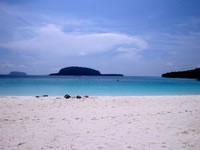Vanuatu: Sustainable Management of Sarakata Watershed (site 2)
Aims: To ensure sustainable management of the Sarakata watershed by formulating and implementing a land use management plan for the watershed
Activities: Participatory ecological and socio-economic surveys, mapping and resource valuation; Establish watershed management strategies, policies, plans and monitoring; Promotion of alternatives to de-forestation, agricultural and coastal management practices; Establish community managed protected areas; Develop and implement Water Safety Plans; Mitigate flooding; Manage watershed for sustainable hydro power.
Improved catchment management
Area under improved catchment management (ha)
"3(b) INDICATOR#2: Sustainable Forest and Land Management practices established and
trialled with Land owners and Lease holders.
The target of the project was to increase the amount of land managed, rehabilitated and protected in
the Sarakata Wateshed. So far 62.5 hectares of land was compensated by the Government of
Vanuatu for the Protection of water source and establishing Water Protection Zones. Also more than
1000 hectares of upland catchment areas have been proposed for Conservation and protected areas
and more than 20 hectares have been identified as priority for reforest rehabilitation.
The Conservation or reserve areas have been agreed by land owners, there are three main
conservation areas where Draft Management Plans has been established with the respected
communities involved and is in the process of being declared by the cabinet. Nurseries have been
established with a number of communities within the Watershed, these nursery seedlings will be
distributed to other communities and schools for planting when they are ready for transplanting.
The nursery sites were identified and selected via an open discussion with the workshop participants"
"2. RESULTS: PROCESS
During the Project Inception phase in 2009 a IWRM Steering Committee was established from the
non-functional Sanma Water Advisory Committee (SWAC). The original members were made up of
the Sanma Water Advisory Committee and expanded to include other important stakeholders for the
IWRM Project. This was done to ensure that the work that the work that the SWAC started would be
incorporated into the Project initiative and logframe.The IWRM Steering Committee expanded to
include department such as Forestry, Fisheries, Agriculture and Livestock.
Fi
Fire
Re-establishment and expansion of this committee has been effective in: (1) opening up the
communication lines between the provincial government and the national government for the better
management of the Sarakata Basin; (2) influencing decision making leaders at the provincial and at
the national level as to the importance of support for the Sarakata Basin; and (3) allowing the relevant
government agencies and other important stakeholders dealing with water on a coordinated effort.
This coordinated collaborative effort has allowed for a signing of MOU with all Directors of the relevant
agencies as well as the different stakeholders for the sustainability of the activities currently
implemented under the IWRM project.
2(a) INDICATOR#1: Establishment of the Sarakata Basin Integrated Flood Management Plan
The plan to incorporate early flood warning system to provide at least one hour warning and process
for incorporating floodplains into planning regulations is well underway with feasibility studies and
Flood Hazard Map mapped out for the Flood Phone areas.
The figure above shows the low lying water table, often surfaced and hence enhanced flood during
extreme weather. Far right is a sample of the Sarakata Flood Hazard Map in three different colours.
White is believed to be areas with low flooding impacts, Yellow is the areas with medium flooding
impacts during flood events, and Red are the areas with high flooding impacts and are areas not safe
for residential activities. It is envisaged that by the end of the project phase, a Sarakata Flood
Management Plan would be endorsed by the Cabinet.
2(b) INDICATOR#2: PROPORTION OF COMMUNITY ENGAGED IN WATER RELATED ISSUES
The target of the project was to establish 30% increase in active engagement activities. At the time of
project start-up almost all community engaged was passive. Vanuatu IWRM has focused on different
targeted community groups participating in clean-up campaigns, construction of composting toilets,
forest replanting, establishment of agriculture demonstration plots. On World Water Day 2012, a river
clean up event on the Sarakata River was a successful day with many community members and
school children attending. It also identified some areas being used for dumping rubbish alongside and
into the Sarakata River. On a separate occasion during a Mass Awareness Campaign of the IWRM
Steering Committee members, a group of young people were identified to clean up and police the
activities along the river mouth of the Sarakata River. The project has subsequently assisted the
community by placing Notice boards and rubbish stands around the area for their rubbish."
| Photo | |
|---|---|
 |
|
| Data | |
|---|---|
| Year | 2012 |
| Reporting date | 14-Mar |
| Related sites |
|---|
|
Ridge to reef: protecting water quality from source to sea in the Federated States of Micronesia
Improved catchment management
Environmental and socio-economic protection in Fiji: Integrated flood risk management in the Nadi River Basin (site 2)
Improved catchment management
Tonga: Improvement and Sustainable Management of Neiafu; Vava’u’s Groundwater Resource
Pollution Reduction to Aquifers: N
Integrated Sustainable Wastewater Management (Ecosan) for Tuvalu
Municipal Wastewater Pollution: N
Integrated Sustainable Wastewater Management (Ecosan) for Tuvalu (site 2)
Water Use Efficiency
Integrated Sustainable Wastewater Management (Ecosan) for Tuvalu (site 3)
Water Use Efficiency |

























